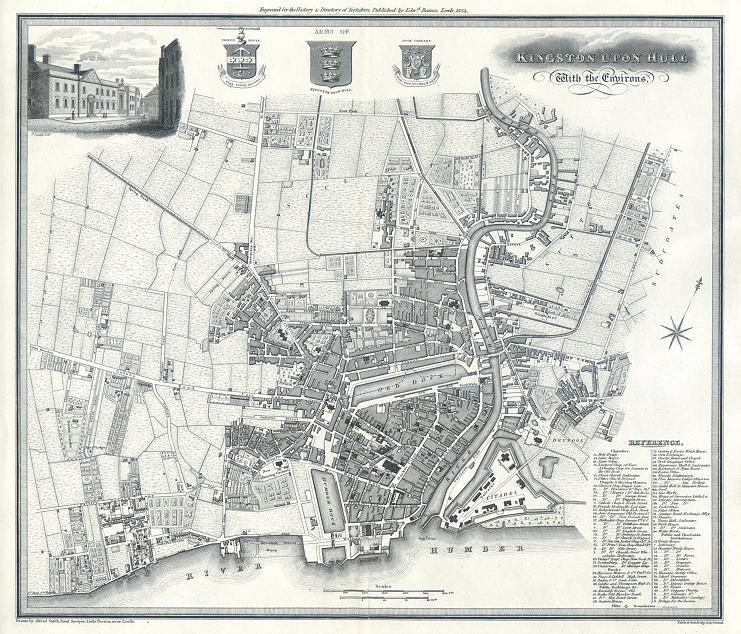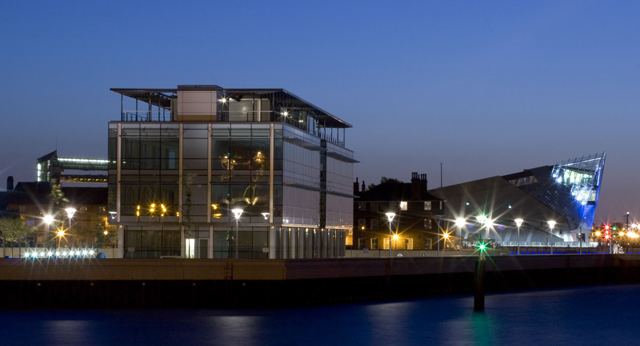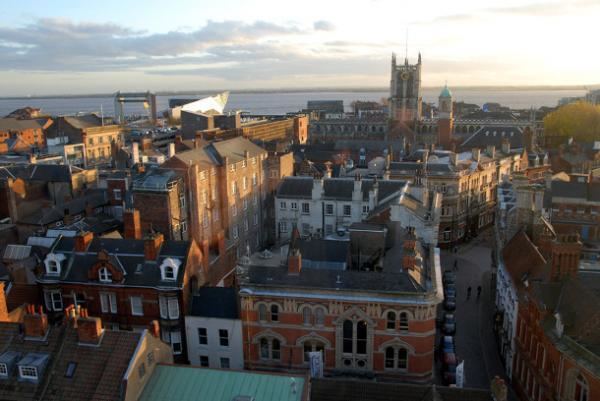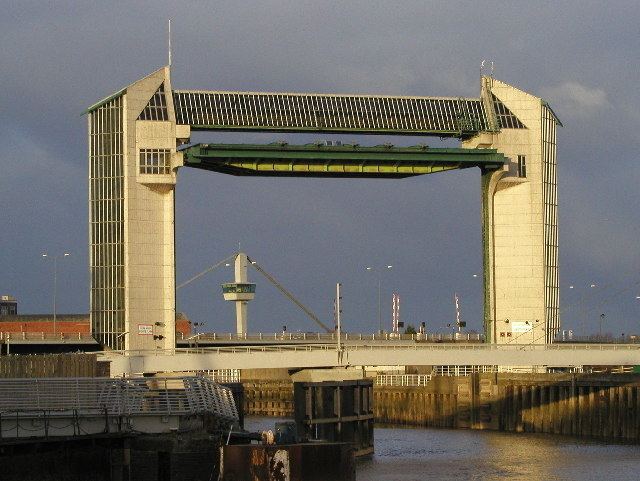Country England Area | Region Yorkshire and the Humber Founded 12th century | |
Colleges and Universities University of Hull, Hull College Points of interest Streetlife Museum of Transport, Humber Bridge, Wilberforce House, Holy Trinity Church - Hull, Ferens Art Gallery | ||
Hull, officially Kingston upon Hull ( KING-st?n ?-pon HUL, ), is a city and unitary authority area in the ceremonial county of the East Riding of Yorkshire, England. It stands on the River Hull at its junction with the Humber estuary, 25 miles (40 km) inland from the North Sea. Hull has a resident population of 256,100 (2011 est.).
Contents
- Map of Kingston upon Hull
- Kingston upon hull skyline
- History
- Geography
- Economy
- Culture
- Museums
- Festivals
- References
Map of Kingston upon Hull
The town of Hull was founded late in the 12th century. The monks of Meaux Abbey needed a port where the wool from their estates could be exported. They chose a place at the junction of the rivers Hull and Humber to build a quay.
The exact year the town was founded is not known but it was first mentioned in 1193, as Wyke on Hull. Renamed Kings-town upon Hull by King Edward I in 1299, the town and city of Hull has served as market town, military supply port, a trading hub, fishing and whaling centre, and industrial metropolis.
Kingston upon hull skyline
Hull was an early theatre of battle in the English Civil Wars. Its 18th-century Member of Parliament, William Wilberforce, played a key role in the abolition of the slave trade in Britain.
The city is unique in the UK in having had a municipally owned telephone system from 1902, sporting cream, not red, telephone boxes.
After suffering heavy damage during the Second World War (the Hull Blitz), Hull weathered a period of post-industrial decline, during which the city gained unfavourable results on measures of social deprivation, education and policing. During the early 21st-century spending boom (before the late 2000s recession) the city saw large amounts of new retail, commercial, housing and public service construction spending.
Established tourist attractions include the historic Old Town and Museum Quarter, Hull Marina and The Deep, a city landmark. The redevelopment of one of Hulls main thoroughfares, Ferensway, included the opening of St. Stephens Hull and the new Hull Truck Theatre. Spectator sporting activities include Premier League football and Super League Rugby. The KC Stadium houses the Hull City football club and Hull FC rugby club and Craven Park is home to rugby club Hull Kingston Rovers. Hull is also home to the Elite Ice Hockey League Hull Stingrays.
In November 2013, it was announced that Hull would be the 2017 UK City of Culture.
History

Kingston upon Hull stands on the north bank of the Humber estuary at the mouth of its tributary, the River Hull. The valley of the River Hull has been inhabited since the early Neolithic period but there is little evidence of a substantial settlement in the area of the present city. The general area was attractive to early developers because it gave access to a prosperous hinterland and navigable rivers, but the actual site was not good, as it was remote and low-lying with no fresh water. It was originally an outlying part of the hamlet of Myton, named Wyke. The name is thought to originate either from a Scandinavian word Vik meaning creek, or from the Saxon Wic meaning dwelling place or refuge.

The River Hull was a good haven for shipping, whose trade included the export of wool from Meaux abbey. In 1293 the town was acquired from the abbey by King Edward I, who on 1 April 1299 granted it a royal charter that renamed the settlement Kings town upon Hull, or Kingston upon Hull. The charter is preserved in the archives of the citys Guildhall.
In 1440, a further charter incorporated the town and instituted local government consisting of a mayor, a sheriff, and twelve aldermen.
In his Guide to Hull (1817), J.C. Craggs provides a colourful background to Edwards acquisition and naming of the town. He writes that the King and a hunting party started a hare which "led them along the delightful banks of the River Hull to the hamlet of Wyke … [Edward], charmed with the scene before him, viewed with delight the advantageous situation of this hitherto neglected and obscure corner. He foresaw it might become subservient both to render the kingdom more secure against foreign invasion, and at the same time greatly to enforce its commerce". Pursuant to these thoughts, Craggs continues, Edward purchased the land from the Abbot of Meaux, had a manor hall built for himself, issued proclamations encouraging development within the town, and bestowed upon it the royal appellation, Kings Town.
The port served as a base for Edward I during the First War of Scottish Independence and later developed into the foremost port on the east coast of England. It prospered by exporting wool and woollen cloth, and importing wine and timber. Hull also established a flourishing commerce with the Baltic ports as part of the Hanseatic League.
From its medieval beginnings, Hulls main trading links were with Scotland and northern Europe. Scandinavia, the Baltic and the Low Countries were all key trading areas for Hulls merchants. In addition, there was trade with France, Spain and Portugal. As sail power gave way to steam, Hulls trading links extended throughout the world. Docks were opened to serve the frozen meat trade of Australia, New Zealand and South America. Hull was also the centre of a thriving inland and coastal trading network, serving the whole of the United Kingdom.
Sir William de la Pole was the towns first mayor. A prosperous merchant, de la Pole founded a family that became prominent in government. Another successful son of a Hull trading family was bishop John Alcock, who founded Jesus College, Cambridge and was a patron of the grammar school in Hull. The increase in trade after the discovery of the Americas and the towns maritime connections are thought to have played a part in the introduction of a virulent strain of syphilis through Hull and on into Europe from the New World.
The town prospered during the 16th and early 17th centuries, and Hulls affluence at this time is preserved in the form of several well-maintained buildings from the period, including Wilberforce House, now a museum documenting the life of William Wilberforce.
During the English Civil War, Hull became strategically important because of the large arsenal located there. Very early in the war, on 11 January 1642, the king named the Earl of Newcastle governor of Hull while Parliament nominated Sir John Hotham and asked his son, Captain John Hotham, to secure the town at once. Sir John Hotham and Hull corporation declared support for Parliament and denied Charles I entry into the town. Charles I responded to these events by besieging the town. This siege helped precipitate open conflict between the forces of Parliament and those of the Royalists.
Throughout the second half of the 19th century and leading up to the First World War, the Port of Hull played a major role in the transmigration of Northern European settlers to the New World, with thousands of emigrants sailing to the city and stopping for administrative purposes before travelling on to Liverpool and then North America.
Parallel to this growth in passenger shipping was the emergence of the Wilson Line of Hull. Founded in the city in 1825 by Thomas Wilson, by the early 20th century the company had grown – largely through its monopolisation of North Sea passenger routes and later mergers and acquisitions – to be the largest privately owned shipping company in the world, with over 100 ships sailing to different parts of the globe. The Wilson Line was sold to the Ellerman Line – which itself was owned by Hull-born magnate (and the richest man in Britain at the time) Sir John Ellerman.
Whaling played a major role in the towns fortunes until the mid-19th century. Hulls prosperity peaked in the decades just before the First World War; it was during this time, in 1897, that city status was granted. After the decline of the whaling industry, emphasis shifted to deep-sea trawling until the Anglo-Icelandic Cod War of 1975–1976. The conditions set at the end of this dispute initiated Hulls economic decline.
Many of the suburban areas on the western side of Hull were built in the 1930s, particularly Willerby Road and Anlaby Park, as well as most of Willerby itself. This was part of the biggest British housing boom of the 20th century (possibly ever).
Geography

At 53°44?30?N 0°20?0?W, 154 miles (248 km) north of London, Kingston upon Hull is on the northern bank of the Humber estuary. The city centre is west of the River Hull and close to the Humber. The city is built upon alluvial and glacial deposits which overlie chalk rocks but the underlying chalk has no influence on the topography. The land within the city is generally very flat and is only 2 to 4 metres (6.5 to 13 ft) above sea level. Because of the relative flatness of the site there are few physical constraints upon building and many open areas are the subject of pressures to build.

The parishes of Drypool, Marfleet, Sculcoates, and most of Sutton parish, were absorbed within the borough of Hull in the 19th and 20th centuries. Much of their area has been built over, and socially and economically they have long been inseparable from the city. Only Sutton retained a recognisable village centre in the late 20th century, but on the south and east the advancing suburbs had already reached it. The four villages were, nevertheless, distinct communities, of a largely rural character, until their absorption in the borough—Drypool and Sculcoates in 1837, Marfleet in 1882, and Sutton in 1929. The current boundaries of the city are tightly drawn and exclude many of the metropolitan areas nearby villages, of which Cottingham is the largest. The city is surrounded by the rural East Riding of Yorkshire.
Some areas of Hull lie on reclaimed land at or below sea level. The Hull Tidal Surge Barrier is at the point where the River Hull joins the Humber estuary and is lowered at times when unusually high tides are expected. It is used between 8 and 12 times per year and protects the homes of approximately 10,000 people from flooding. Due to its low level, Hull is expected to be at increasing levels of risk from flooding due to global warming.
Many areas of Hull were flooded during the June 2007 United Kingdom floods, with 8600 homes and 1300 businesses affected.
Historically, Hull has been affected by tidal and storm flooding from the Humber; the last serious floods were in the 1950s, in 1953, 1954 and the winter of 1959.
Unlike many other English cities, Hull has no cathedral. It is in the Diocese of York and has a Suffragan bishop. However, Hulls Holy Trinity Church is the largest parish church in England when floor area is the measurement for comparison. The church dates to about 1300. Hull forms part of the Southern Vicariate of the Roman Catholic Diocese of Middlesbrough and included among Hulls Catholic churches is St Charles Borromeo, the oldest post-Reformation Roman Catholic church in the city.
There are several seamens missions and churches in Hull. The Mission to Seafarers has a centre at West King George Dock and the St Nikolaj Danish Seamens Church is located in Osborne Street.
Economy
The economy of Hull was built on trading and seafaring, firstly whaling and later seafishing. Merchants houses such as Blaydes House and some warehouses survive in the Old Town, where trade was centred on the River Hull, later shifting to the Humber docks. Another major industry was oilseed crushing. Although the fishing industry declined in the 1970s, the city remains a busy port, handling 13 million tonnes of cargo per year. The port operations run by Associated British Ports and other companies in the port employ 5,000 people. A further 18,000 are employed as a direct result of the ports activities. The port area of the city has diversified to compensate for the decline in fishing by the introduction of Roll-on Roll-off ferry services to the continent of Europe. These ferries now handle over a million passengers each year. Hull has exploited the leisure industry by creating Hull Marina from the old Humber Street Dock in the centre of the city. It opened in 1983 and has 270 berths for yachts and small sailing craft.
Culture

Hull has a vibrant tradition of arts and culture with several museums of national importance. The city has a strong theatrical tradition with some famous actors and writers having been born and lived in Hull. The citys arts and heritage have played an important role in attracting visitors and encouraging tourism in recent efforts at regeneration. Hull has a diverse range of architecture and this is complemented by parks and squares and a number of statues and modern sculptures. The city has proved inspired many authors including Val Wood who has set many of her best-selling novels in the city.

In April 2013 Hull put forward a bid to be the UK City of Culture in 2017, reaching the shortlist of four in June 2013 along with Dundee, Leicester and Swansea Bay. On 20 November 2013, Maria Miller, the Culture Secretary, announced that Hull had won the award to become the UK City of Culture 2017.
Museums
Hulls Museum Quarter, on the High Street in the heart of the Old Town, consists of Wilberforce House, the Arctic Corsair, the Hull and East Riding Museum (which contains the Hasholme Logboat – Britains largest surviving prehistoric logboat), and the Streetlife Museum of Transport. Other museums and visitor attractions include the Ferens Art Gallery with a good range of art and regular exhibitions, the Maritime Museum in Victoria Square, the Spurn Lightship, the Yorkshire Water Museum, and the Deep, a public aquarium. The recently refurbished Seven Seas Fish Trail marks Hulls fishing heritage, leading its followers through old and new sections of the city, following a wide variety of sealife engraved in the pavement.
Visual culture and sculpture
Marine painter John Ward (1798–1849) was born, worked and died in Hull and a leading ship artist of his day. Artist and Royal Academician David Remfry (born 1942) grew up in Hull and studied at the Hull College of Art (now part of Lincoln University) from 1959 to 1964. His tutor, Gerald T Harding, trained at the Royal College of Art, London and was awarded the Abbey Minor Travelling Scholarship in 1957 by the British School in Rome. Remfry has had two solo exhibitions at the Ferens Art Gallery in 1975 and 2005.
Hull has a number of historical statues such as the Wilberforce Memorial in Queens Gardens and the gilded King William III statue on Market Place (known locally as "King Billy"). There is a statue of Hull-born Amy Johnson in Prospect Street. In recent years a number of modern art sculptures and heritage trails have been installed around Hull. These include a figure looking out to the Humber called Voyage which has a twin in Iceland. In July 2011, this artwork was reported stolen. There is a shark sculpture outside The Deep and a fountain and installation called Tower of Light outside Britannia House on the corner of Spring Bank.
Running along Spring Bank there is also an elephant trail, with stone pavers carved by a local artist to the designs of members of the community. This trail commemorates the Victorian Zoological Gardens and the route taken daily by the elephant as it walked from its house down Spring Bank to the zoo and back, stopping for gingerbread at a shop on the way. The animals are further represented on the Albany Street Home Zone a project involving local residents and resulting in sculptures of a hippo (Water Horse) at the bottom of Albany Street; an elephant balancing on its trunk on an island in the middle; and two bears climbing poles and reaching out to each other to form an open archway across the entrance to Albany street from Spring Bank. Other sculptural details of animals along the street represent the participation of street residents, either through workshops with artists and makers, or through independent work of their own.
In 2010 a public art event in Hull city centre entitled Larkin with Toads displayed 40 individually decorated giant toad models as the centrepiece of the Larkin 25 festival. Most of these sculptures have since been sold off for charity and transported to their new owners. Visitors to Hulls Paragon Interchange are now greeted by the new statue of Philip Larkin unveiled on 2 December 2010.
Festivals

The Humber Mouth literature festival is an annual event and the 2012 season featured artists such as John Cooper Clarke, Kevin MacNeil and Miriam Margolyes. The annual Hull Jazz Festival takes place around the Marina area for a week at the beginning of August.

As of 2008 Hull has also held Freedom Festival; an annual free arts and live music event that celebrates freedom in all its forms. Performers have included Pixie Lott, JLS and Martha Reeves and The Vandellas and The 1975 as well as featuring a torchlight procession, local bands like The Talks and Happy Endings from Fruit Trade Music label and a Ziggy Stardust photo exhibition including photos of the late-Hull-born Mick Ronson who worked with David Bowie.
Early October sees the arrival of Hull Fair which is one of Europes largest travelling funfairs and takes place on land adjacent to the KC Stadium.
The Hull Global Food Festival held its third annual event in the citys Queen Victoria Square for three days – 4–6 September 2009. According to officials, the event in 2007 attracted 125,000 visitors and brought some £5 million in revenue to the area. In 2007 the Hull Metalfest began in the Welly Club, it featured major label bands from the United States, Canada and Italy, as well as the UK. The first Hull Comedy Festival, which included performers such as Stewart Lee and Russell Howard was held in 2007.
In 2010, Hull marked the 25th anniversary of the death of the poet Philip Larkin with the Larkin 25 Festival. This included the popular Larkin with Toads public art event. The 40 Larkin toads were displayed around Hull and later sold off in a charity auction. A charity appeal raised funds to cast a life-size bronze statue of Philip Larkin, to a design by Martin Jennings, at Hull Paragon Interchange. The statue was unveiled at a ceremony attended by the Lord Mayor of Hull on 2 December 2010, the 25th anniversary of Larkins death. It bears an inscription drawn from the first line of Larkins poem, The Whitsun Weddings.
In 2013, from 29 April to 5 May, Hull Fashion Week took place with various events happening in venues in and around Hulls City centre. It finished with a finale on 5 May at Hull Paragon Interchange, when recently reformed pop group Atomic Kitten appeared in a celebrity fashion show.
On 3 August 2013, the second Humber Street Sesh Festival took place celebrating local music talent and arts, with several stages showcasing bands and artists from the Fruit Trade Music Label, Humber Street Sesh and Purple Worm Records.
